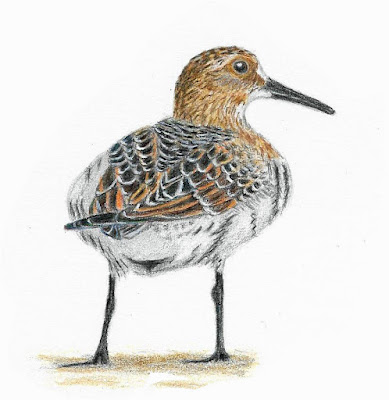 |
| Scratching an itch. Graphite drawing by Greg Gillson. |
On August 27th I was able to locate a previously discovered Baird's Sandpiper on the beach at Imperial Beach, California. It was readily approachable or, rather, it fearlessly approached near me as I sat motionless and as it foraged among the beach-cast kelp on the upper beach. I was able to obtain many photos at close range.
 |
| Stepping into a depression. Graphite drawing by Greg Gillson. |
One thing many birders noted about this bird was how unusually wide the body of this bird sometimes appeared. The breast feathers flared out widely covering the lower part of the folded wings. I have noted ducks give a very wide-bodied appearance like this, but never other birds. It's something I'll have to pay more attention to. If you think I surely must have misdrawn the proportions, please look at the reference photo below.
I was especially pleased to photograph and draw interesting postures that aren't depicted in bird books that usually show the rather uninteresting "field guide" pose.
 |
| "Field Guide" pose. |
The identification of Baird's Sandpiper is rather subtle. At first glance it seems to match the field marks of the smaller North American "peep"--Western, Semipalmated, and Least Sandpipers. The bill is about the same length as the head as the Semipalmated and Least Sandpipers. The legs are black as the Western and Semipalmated Sandpipers. Baird's Sandpipers are a bit larger than the other three, however, if they are seen together.
One noteworthy identification mark is that the wing tips extend quite far past the end of the tail. This gives a very long attenuated look to the rear of the body. In general, birds that migrate long distances have long wings; birds that don't migrate have short wings.
 |
| Looking behind. Colored pencil by Greg Gillson. |
In the fall of the year, juveniles, such as the one depicted, have rows of white tipped back and scapular feathers. These create a "scaly" appearance to the upper parts. Adults are not nearly as bold.
Baird's Sandpiper breed at the northern edge of land in the Arctic, from northeastern Siberia, Alaska, Canada, to northwestern Greenland. When they migrate south they may be found on ocean beaches. But it is not unusual to encounter them on mountain glaciers. In winter they can be found in the Andes of South America in Ecuador and Chile, but also in lower areas in Bolivia, Argentina, Costa Rica, Panama, and Venezuela. Spring migration is through Central American and Mexico and north generally east of the Rocky Mountains in North America. They are a bit more widespread in fall migration, reaching all the way to the Pacific Coast in low numbers, as this bird.
 |
| Portrait: Baird's Sandpiper. |









No comments:
Post a Comment
I really want to hear from you! I've changed settings (again) in order to try to make commenting easier without opening it up to spammers. Please note, however, that comments to posts older than 14 days will be moderated. Thank you.